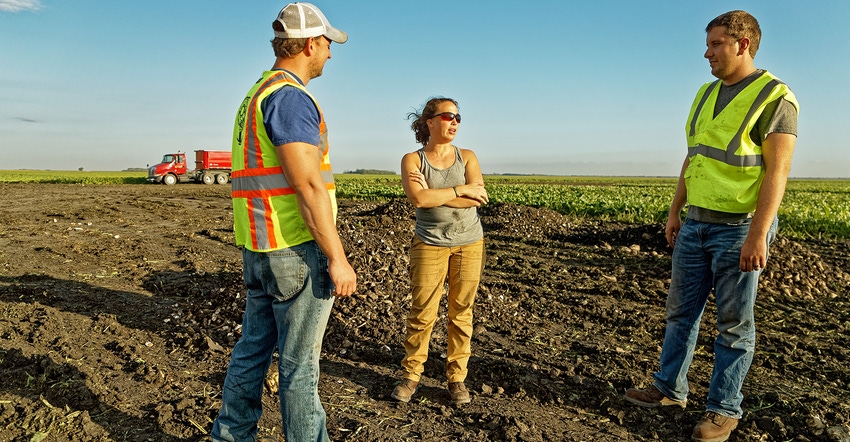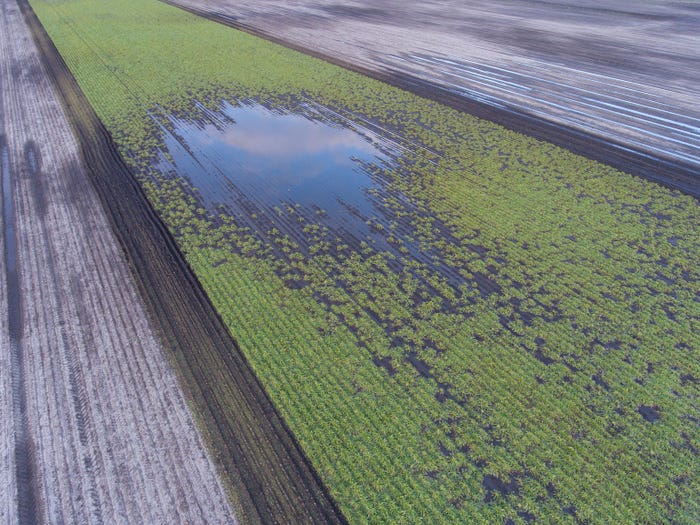January 29, 2020

Corn may be king for many farmers, but in the Red River Valley sugarbeets are typically the most profitable for growers to be successful.
The challenges and harvest of 2019 may have ended that success for some farmers on both sides of the Minnesota-North Dakota border. Between excessive precipitation and an early freeze, yields for the farmer-owned cooperatives in the Red River Valley dropped dramatically and many acres were left unharvested.
“This was the most beets we left unharvested in American Crystal Sugar’s history,” says Joe Hastings, general agronomist who works with American Crystal Sugar Co.
Of the 398,000 acres contracted, 115,000 acres of sugarbeets were never harvested. Instead of processing the anticipated 12 million tons of beets, American Crystal Sugar was lucky to get 7.4 million tons because farmer-members worked themselves and their equipment hard in miserable conditions.
Although the season may be behind them, challenges continue. As spring approaches, growers must deal with sugarbeets in the ground. Retirement and a really, really bad year will end it for some farmers while others continue on.
Battling nature
The trouble started in 2018 with a wet fall when farmers struggled to harvest sugarbeets. That was followed by a wet spring when every crop went into the ground late and in poor conditions. Sugarbeet planting was about six days behind the 10-year average, wrapping up around the first of June. The rains continued. Instead of the ideal 13 inches of rain, some areas were drenched with 24 inches of rain.
“Dad says you pray for an inch at a time. Sometimes you get more than you want,” says Rachel Arneson, a third-generation sugarbeet grower who farms with her dad and brother near Halsted, Minn.
The ground never had a chance to dry out. In August, producers started preharvest to begin the processing season. Growers typically start on headlands and hard-to-access areas, following cooperative guidelines of how many tons they can preharvest.
For some growers, those were the only sugarbeets harvested.
October, when full stockpile harvest begins, was so wet that farmers couldn’t get in the fields until late in the month. Temperatures dropped. The ground froze. Sugarbeets froze. Processors couldn’t use beets with dirt frozen to them. Producers adjusted equipment to harvest only clean beets and worked around the clock. Work that was hard on equipment and workers.
 WEATHER CHALLENGES: Preharvest season was late and wet, and for some growers it was the only time that sugarbeets were harvested in 2019.
WEATHER CHALLENGES: Preharvest season was late and wet, and for some growers it was the only time that sugarbeets were harvested in 2019.

“We typically run 24 hours, but some nights we had to quit because of freezing temperatures,” Arneson says. “It was a very physically and emotionally taxing year. It hit the entire community.”
For American Crystal Sugar growers, the battle ended Nov. 9 when the company closed the season.
Extras made the difference
“We were very fortunate that we got just over 90% harvested,” Arneson says.
Out of 600 planted acres, about 60 acres of sugarbeets were not harvested. She credits that to the foresight of her father, Ray. In 2017, despite her hesitancy to make the investment, her father purchased an Amity sugarbeet cart with tracks. Without the tracks, Arneson says, they wouldn’t have been able to harvest what they did.
For others, tiling made the difference. Those acres were slightly drier, making harvest possible, though messy. Investments in tiling, ditching and best water management practices helped in many fields, while in other fields conditions were too difficult to overcome and some growers were not able to harvest many acres at all.
To harvest or not to harvest
It was a bad season for growers financially, whether they harvested or not. Payments were the lowest in recent crop history.
“Growers who harvested beets barely broke even or lost money,” Arneson says. “And those who didn’t [harvest] were dependent on crop insurance — and for most it’s likely not enough to cover both the co-op’s unharvested acres assessment to its grower owners and input costs of seed, fertilizer, chemicals and in-season labor.”
The growers who were able to harvest what they could did so with ethical and practical motives — for the viability of the cooperative, of which they are shareholders.
Financially, there may be some relief. A coalition of sugarbeet cooperatives is working with USDA for potential disaster payments through Wildfire and Hurricane Indemnity Program Plus (WHIP+). Benefits would be shared with cooperatives and farmers to offset losses.
Spring work questions
While Arneson was fortunate to harvest most of her beets, she — like many other growers — was unable to do any fall tillage on sugarbeets and other fields. Usually all 4,000 acres have been tilled, but she only worked about 20% of the ground last fall. In January, she started mapping rotation plans so that beets won’t be in the same fields for years to come to prevent disease and other problems. She was considering trading tillage equipment for heavier duty equipment that could till and prepare the seedbed in one pass.
Hastings says it’s impossible to know what type of tillage will work best until spring arrives and what implements fit those soil conditions and the remaining crop residue. A lighter spring tillage pass may be appropriate in some case, and in others a more aggressive one will work better for residue incorporation. Growers who were able to get a topper into fields in the fall were told to shred the tops and foliage to speed the breakdown of leaves and the release of nitrogen, but not to till up the beets as they decay faster when left in the soil.
For growers such as Arneson who must deal with beets and foliage, Hastings says his top recommendation is to plant soybeans.
“The soybeans being planted a bit later may allow more time for the ground to dry out, and they can offset the planter to plant in between the rows [of sugarbeets],” he says, adding soybeans also won’t need additional nitrogen. A second option is planting edible beans for the same reasons.
Growers who plant wheat or corn will have to use appropriate tillage to create a good seedbed and do soil testing, as an additional 30 to 50 pounds per acre of nitrogen will need to be applied. Details about other nutrients, disease and other information will be shared with growers at winter cooperative meetings and in conjunction with the University of Minnesota and North Dakota State University.
Tapping resiliency
Arneson, who rejoined the family farm in 2012, admits that if her first years were like 2018, dealing with snow and mud, and then last year, she would probably not be farming today.
“It was not a winning year for anyone,” she says.
Yet, she finds hope in the camaraderie of shared pain and people acknowledging mental health challenges and reaching out to each other. She’d like to see that continue.
“I found a new sense of what resilience truly is,” Arneson says. “I still very much enjoy what I’m doing. I don’t see this as a long-term trend. We can think ahead and have hope.”
Goerge is a freelancer based in Parkers Prairie.
You May Also Like




